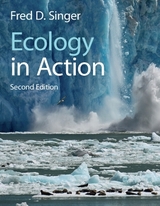
Ecology in Action
Cambridge University Press (Verlag)
978-1-107-11537-8 (ISBN)
Taking a fresh approach to integrating key concepts and research processes, this undergraduate textbook encourages students to develop an understanding of how ecologists raise and answer real-world questions. Four unique chapters describe the development and evolution of different research programs in each of ecology's core areas, showing students that research is undertaken by real people who are profoundly influenced by their social and political environments. Beginning with a case study to capture student interest, each chapter emphasizes the linkage between observations, ideas, questions, hypotheses, predictions, results, and conclusions. Discussion questions, integrated within the text, encourage active participation, and a range of end-of-chapter questions reinforce knowledge and encourage application of analytical and critical thinking skills to real ecological questions. Students are asked to analyze and interpret real data, with support from online tutorials demonstrating the R programming language for statistical analysis.
Fred D. Singer is Professor Emeritus of Biology at Radford University, where he began teaching in 1989. A committed teacher, he developed research programs on the behavioral and community ecology of spiders, dragonflies and zebrafish, while also collaborating with several colleagues to promote active learning as part of an ongoing research program on new approaches to teaching. In 2000, in recognition of his dual research programs, he was awarded the Radford Foundation Award for Creative Scholarship. He has taught approximately 20 different courses, including general ecology, field ecology and climate change ecology, using the philosophy that the best learning occurs when students deal with real experiments and real data.
Preface; Acknowledgements; Part I. Introduction and the Physical Environment: 1. What is ecology in action?; 2. The physical environment; Part II. Evolutionary and Organismal Ecology: 3. Evolution and adaptation; 4. Physiological and evolutionary ecology of acquiring nutrients and energy; 5. Physiological and evolutionary ecology of temperature and water relations; 6. Behavioral ecology; 7. Bernd Heinrich - studying adaptation in the field and the laboratory; Part III. Population Ecology: 8. Life history evolution; 9. Distribution and dispersal; 10. Population abundance and growth; 11. Conservation ecology; 12. The chimpanzees of Gombe; Part IV. Community Ecology: 13. Interspecific competition; 14. Predation and other exploitative interactions; 15. Facilitation; 16. Complex interactions and food webs; 17. Biological diversity and community stability; 18. Dan Janzen and Winnie Hallwachs - community interactions and tropical restoration through biodiversity conservation; Part V. Ecosystem and Global Ecology: 19. Ecosystem structure and energy flow; 20. Nutrient cycles: global, regional and local; 21. Disturbance and succession; 22. Geographic and landscape ecology; 23. The carbon cycle and climate change ecology; 24. Jane Lubchenco - from the marine intertidal to global service; 25. Epilogue; Glossary; References; Figure and quotation credits; Index.
| Erscheint lt. Verlag | 10.3.2016 |
|---|---|
| Zusatzinfo | Worked examples or Exercises; 88 Tables, color; 370 Halftones, color; 185 Line drawings, color |
| Verlagsort | Cambridge |
| Sprache | englisch |
| Maße | 222 x 283 mm |
| Gewicht | 2200 g |
| Themenwelt | Naturwissenschaften ► Biologie ► Ökologie / Naturschutz |
| ISBN-10 | 1-107-11537-X / 110711537X |
| ISBN-13 | 978-1-107-11537-8 / 9781107115378 |
| Zustand | Neuware |
| Haben Sie eine Frage zum Produkt? |
aus dem Bereich



